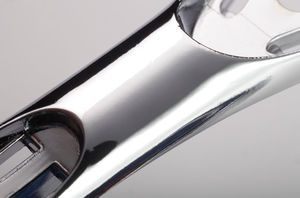

- Products
- Catalogs
- News & Trends
- Exhibitions
Decorative chrome plating steelzincaluminum




Add to favorites
Compare this product
Characteristics
- Type
- decorative
- Substrate
- steel, zinc, aluminum
- Applications
- for the automotive industry
- Certifications
- ISO 14001
Description
Chrome plating is a proven, extremely versatile coating process that stands out because of its extensive list of positive properties. It is highly decorative, corrosion resistant, hydrophobic, and abrasion and wear resistant. Its hardness and resistance to oxidising media are especially noteworthy.
Chromium also plays a major role as a partner in multi-layer coating systems, underscoring its decorative or functional properties even more. Chrome layers are used in countless applications and are currently almost impossible to replace for many products with all of their advantages
Chromium is a bluish-white, brittle metal that can be mechanically polished to a high gloss. A particularly important feature of chromium is its behaviour towards oxidising media. When treated with nitric acid or oxidising acid mixtures, chromium becomes passive. Atmospheric oxygen also causes passivity of the active chromium, which means that passive chromium is close to precious metals in terms of value. Chromium's known tarnish resistance and its good corrosion resistance are based on this passivity. Chromium is resistant to phosphoric acid, acetic acid, citric acid, tartaric acid and most other organic acids. Metallic chrome is resistant to dry air. It barely corrodes in humid air. Chromium is also resistant in alkaline media, as long as no strong oxidising conditions are present.
Related Searches
- Anodic oxidation
- Aluminum anodic oxidation
- Anodic oxidation with coloring
- Nickel plating
- Painting
- Painting on metal
- Powder coating
- Hard anodizing
- Zinc-plating
- Galvanizing
- Automotive anodic oxidation
- Hot dip galvanizing
- Medical anodizing
- Metallization
- Chrome plating
- Industrial anodizing
- High phosphorus nickel plating
- Titanium anodizing
- Steel nickel plating
- Aluminum nickel plating
*Prices are pre-tax. They exclude delivery charges and customs duties and do not include additional charges for installation or activation options. Prices are indicative only and may vary by country, with changes to the cost of raw materials and exchange rates.




